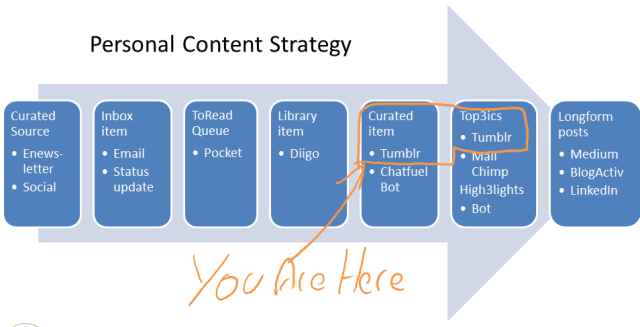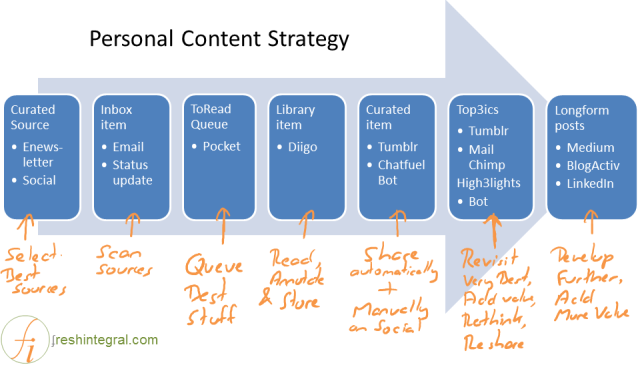So what’s a Hub?
(2020 update: this post was published in 2013, as I created a first version of MyHub on Tumblr, and then updated in 2017, before being transferred to MyHub.ai in 2020)
This Tumblr is a placeholder, or trial run, for a site I’d like to build one day: a Content Hub.
I’ve written the specs, so maybe one day… In the meantime, here’s what I mean. If anyone knows of a tool which does this, let me know.
2017 Update: Personal Content Strategy
When I launched this Hub in 2012 I was groping towards what I now call my Personal Content Strategy. Since then I’ve added an enewsletter (browse, subscribe) in Aug 2015 and a CuratorBot on Messenger in late 2016 (details), so time for a quick update.

A strategy for managing content: from the Curated Sources I scan (left) for interesting content, through to the longform blog posts I publish (right).
Most of the content on this Hub is Stuff I Like - i.e., the public face of my Personal Library of useful articles, blog posts, tools and more.
Along with short summaries of my work (Stuff I Do), you’ll also find links to my longform blog posts (Stuff I Think), which includes my To3pics newsletter editions, where I assemble my thoughts for my next longform post.
All resources are tagged, so (when the tagcloud generator works) users can find Stuff I Like, Think and Do about hundreds of different topics - for example, productivity.
A Content Pipeline
The above strategy is integrated into my GTD-based personal productivity system, and has several steps to ensure I learn and think about the content published by the sources I Curate (i.e., actively choose to read, left):

It’s a pipeline: a lot of content enters from the curated sources (left), with less and less content making it through to the right. The further along each piece of content gets, the more I think about it, until I end up writing my own.
In the middle, for example, I Store useful resources in my Library. This is much more involved than mindlessly Liking it, or adding a nice yellow star: I annotate and tag it in Diigo, which forces me to read it carefully and extract the most useful insights. Including the tag ‘like’ means it automatically appears in Stuff I Like.
Even fewer pieces of content make it into Top3ics, where I reread and reflect on a subset of these resources again. And then I revisit an even smaller subset of them for my longform posts - ie, What I Think, (right).
More: see Stop drowning in your Inbox, which is when I added Source Curation to my original process (Manage the Firehose or it will manage you).
And now, back to my 2013 post…
Is it a blog?
First and foremost, a Hub is not that much more than a personal blog, in that it’s a site to share your thoughts.
But the way I see it, what you like on the web - stuff that interests, educates, inspires or amuses you - is almost as much an expression of who you are as your opinions (blog posts, tweets, whatever) and your actual work (projects, activities, portfolio, etc.).
Yet while there are 1000s of tools to like and share stuff, and thousands more to publish stuff, it’s damned near impossible to seamlessly bring all this stuff together in a way that makes sense.
Is it a Library? A portfolio?
Partly the problem is the stream metaphor that dominates today - follow me on Platform X and you get a stream of stuff I like on that platform.
Follow me on Platform Y, on the other hand, and you’ll get a stream of thoughts I choose to publish there.
Social platforms are useful for keeping up to date, but useless for organising content long-term because they put your information in siloed streams.
Let’s say you follow me on LinkedIn and like something I shared there about content marketing.
Fantastic, but good luck trying to find something relevant to that (i.e., something else on content marketing) that I shared last month on Twitter, or something I wrote extensively about 4 months ago on Medium, or did 2 years ago someplace else.
You need a library which brings all this together. So why not publish your library - or at least part of it? After all, curating and sharing your resources is a great way to add value to your readers, establish your brand, yada yada yada.
And a lot of people also need to keep track of - and present - the stuff they do. Which is - hopefully for them - closely related to the stuff they think and the stuff they like.
So why not bring it all together?
In short, I want a Hub, where I can bring together the stuff I Like, Think and Do in a single place, even if that stuff is actually distributed all over the Web, and make everything easier to find than on social media.
In the Hub, everything is tagged and categorised consistently, with semantic tagging and faceted search* helping people seamlessly explore:
- the stuff you Like (your Library);
- the stuff you Think (Posts);
- and the stuff you Do (Portfolio).
To continue the above example, content marketing on this Hub brings together everything I’ve liked from around the Web, along with any blog posts I’ve written and projects I’ve implemented, about content marketing.
Trialling the Hub with Tumblr
Finally, a Hub needs to integrate with the way I manage content across my private, personal and professional online spaces, as set out in Taming the Firehose.
This Tumblr, therefore, is a placeholder and trial run, a place where I try out stuff before embarking on anything bigger and better. Unless Yahoo! introduce automatic semantic tagging and faceted search one of these days…
Got any ideas or tips I could use to build this? Let me know.
* PS This Hub doesn’t have faceted search because it’s Tumblr, a free of charge blogging platform, and the semantic tagging is 100% manual. Read about combining automated semantic analysis and faceted search.
Related reading
More Stuff I Think
More Stuff tagged curation , gtd , newsletter , intro
See also: Content Strategy , Digital Transformation , Personal Productivity , Media , Communications Strategy